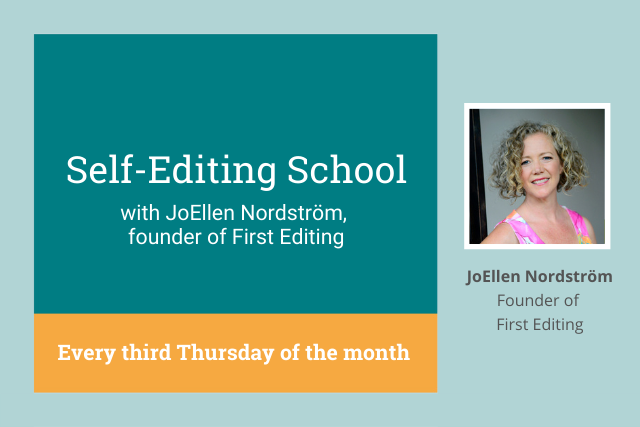Watch JoEllen's live training on How to Edit Faster and More Efficiently, then keep reading for more tips:

Self-edit your novel faster in an organized fashion using the 38 Story Elements as your guideline.
The 38 story elements are a system created by the folks at Fictionary to help you work your way through every aspect of your novel when writing and editing.
Begin by evaluating your characters, scenes, and plot to ensure that each area is engaging your readers by simultaneously pushing your story forward.
Every word you include in your book needs to have purpose. As Certified Story Coaches and professional editors at FirstEditing, this is our daily job. Today, I will share a basic outline of the elements we evaluate during the structural editing process of fiction novels.
You can self-edit using this list before submitting your manuscript for structural editing. Or, you can use this list to better understand the structural editing process. I encourage you to only hire certified editors who are trained in structural story editing.
Standardize Your Story Formatting
Every structural edit starts with preparation. First, as the author, you need to ensure that you have each chapter identified by placing “Chapter (One/1)” at the beginning. Do this with every chapter in the same format throughout your entire book.
Additionally, you must also format each scene with a scene break. Traditionally, this is a blank line followed by a line with three asterisks centered, but now there are many ornamental choices.
Regardless, uniformity is important. You must select one type of scene break and then use it in the same method throughout your book’s formatting. Identify every scene in your book using this method.
Identify Your Promise to Your Readers
Create a book blurb. You need this for your own reference and it is essential when you submit for professional editing. Your book blurb is your promise to your readers. It is what you will deliver in your story.
Assess Your Scenes
Begin by naming each of your scenes. Yes, every single scene. If you can’t name it, why does it exist? This is important and is part of the 38 elements for editing.
Next, record and assess the word count of each chapter and scene to determine the balance within your writing. Any severely long scenes should indicate an important event in your story. If not, you will want to decide how to fix this imbalance.
Locate, identify, and highlight the key elements of the story arc.
- Inciting incident
- Plot point 1
- Middle
- Plot point 2
- Climax
- Resolution
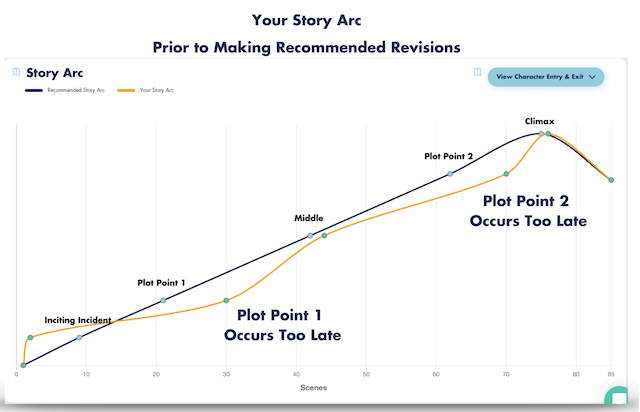
Credit: Fictionary
Certified Story Coaches combine their experience and training in conjunction with licensed editing software. Thus, you get professional graphics during the edit to better assess and fix your overall story arc.
By identifying these areas, you can assess if you are achieving these goals within the scenes and overall structure of your book.
Get Ready to Edit
Great! You now have created the basic foundations for editing the structure of your book. Let’s get started.
We will assess every scene and chapter using the 38 Story Elements checklist below as the fundamental minimum.
Remember that a certified, professional editor will be combining these objectives with the subjective evaluation of your writing in comparison to your genre. However, this is a very good foundation from which to begin.
Be prepared and be thorough as you begin this process. By including these essential story elements, you are strengthening the foundation of your story.
The 38 Story Elements for Fiction
We will start by assessing the characters within your entire story. Thus, you need a complete list of every character in your book and what their significance is. Keep this master list for reference as you work your way through your book.
There are 38 different elements for each scene, so organization is essential if you are going to tackle this during a self-edit. We will review this in three separate sections as the character elements, plot elements, and setting elements.
Character Story Elements
Your characters are what draw your readers in and connect them to your story. It's important to get them right.
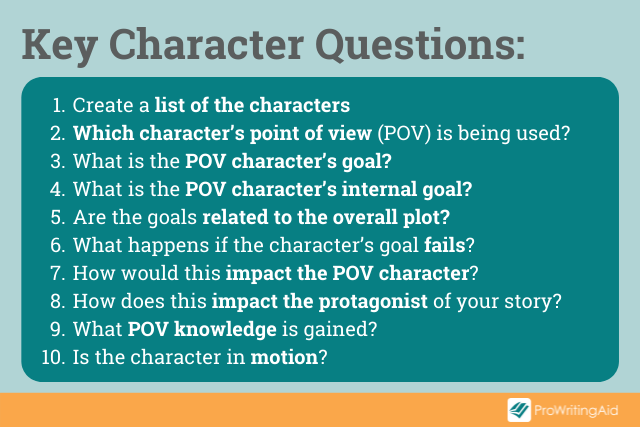
Now as you work through your manuscript, you need to identify and record the following character elements for each scene:
1) Create a list of the characters
2) Identify which character’s point of view (POV) is being used
3) Determine the POV character’s goal
Once you have tackled these basic character elements, dig deeper into the advance character elements by taking the following steps:
4) Identify the POV character’s internal goal
5) Assess if these goals are related to the overall plot
6) Determine what happens if the character’s goal fails
7) Identify how this impacts the POV character
8) Identify how this impacts the protagonist of your story
9) Assess what POV knowledge is gained
10) Determine if the character is in motion
Setting Story Elements
As you read through and evaluate each scene, you also need to identify and review the setting elements to ensure that your reader will be immersed in the world of your story.
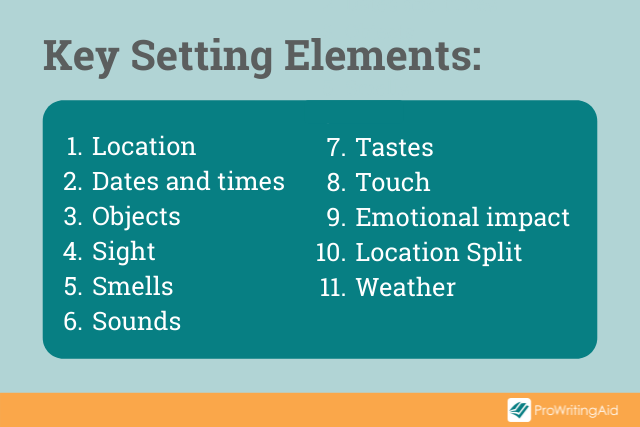
Incorporate a variety of these settings into your scenes to ensure they are interesting and diverse.
Locate and record how the following settings are used for each scene:
11) Location
12) Dates and times
13) Objects
14) Sight
15) Smells
16) Sounds
17) Tastes
18) Touch
19) Emotional impact
Determine that you are using these basic setting elements in a variety of manners to strengthen your story and engage your readers.
It’s important to balance the five senses in your description. If you only rely on sight, your descriptions could become flat.
ProWritingAid’s Sensory Check highlights all of the sensory words in your document, and shows you how many sight, sound, smell, taste, and hearing words you have used throughout your scene in a handy list:
You’ll be able to tell where you need to add more variety in just a matter of minutes.
Once you’ve checked your scene for sensory balance, check to see if you are also including the more advanced setting elements:
20) Location Split
21) Weather
Creatively include these elements to enhance the impact of your story.
Plot Story Elements
The most in-depth structural evaluation of your story involves the plot elements. As you go through each scene, identify and record the following:
22) Scene name (which you did at the very beginning)
23) Story arc (determining the key factors of the story)
24) Purpose of the scene (this is known only after reading the entire story)
25) Opening type
26) Closing type
27) Anchored
28) Entry hook
29) Exit hook
Lastly, you will want to determine if, how, and where you are using the advanced plot elements.
Therefore, you need to identify the use of the following advanced plot elements:
30) Tension
31) Conflict
32) Revelation
33) Backstory
34) Flashback
35) Scene middle
36) Scene climax
37) Action/sequel
38) Reader knowledge gained
Get more in-depth information for each of the 38 Story Elements, plus VIP access to all our handouts, podcasts, videos, and more by clicking here.

When Should You Contact an Editor?
Once you have completed your first round of editing, reach out to a certified structural editor. They will evaluate your overall composition and advise you personally on how to proceed in the editing process.
If you are a strong learner and have successfully edited the structure of your novel, a professional editor will advise if you should proceed to line editing or copy editing.
These key story elements are the foundations of creating a strong story. However, they are not all-inclusive. You will need to learn about the story arc and overall creative structure of your story. Your professional editor will also review and comment on your story for consistency of voice, transition, flow, and much more.
During the initial structural edit, your editor is reviewing the high-level content. They are not correcting in-depth the grammar, spelling, punctuation, and such.
Your structural editor will comment briefly on syntax and grammar rules so that you can strengthen such issues during your revisions. However, as you will be making many significant changes to the overall story and manuscript structure, these other editorial concerns will be tackled in-depth during the line editing or copy editing phase.
Know When to Stop
Remember, editing is a journey. By learning how to edit, you will also strengthen your writing skills.
However, if at any time the editing overwhelms or takes the joy out of writing, I encourage you to reach out to one of our certified structural story editors. They can do most of this for you. Plus, you can connect with us directly with the click of a button from ProWritingAid.
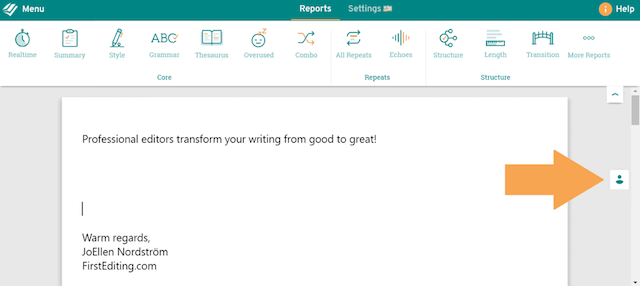
Get your free editing sample plus 15% off with discount code SelfEditing2021.

